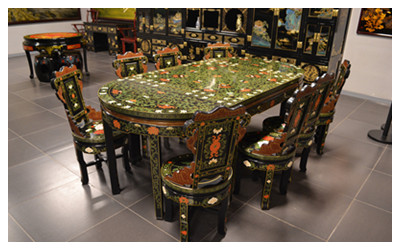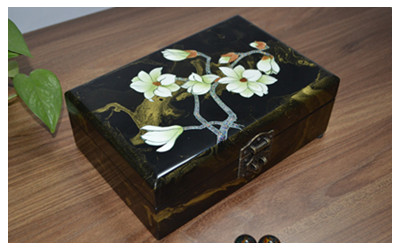
Pingyao polished lacquer wares are specialty to buy while you travel in Pingyao Ancient City. The polished lacquer wares also are also called the golden lacquer furniture.
The polished lacquer wares, with shiny and smooth surface, exquisite painting, distinctive colors, and proportionate lines, can not only be used for decoration because of their unique national feature and local style, but have practical values as well, because they are smart but firm, water-proof and can stand the high temperature.
The polished painted devices are made of lacquer trees,which is also called old lacquer tree or big lacquer tree. The making procedure is unique. Firstly, select the suitable woods and make models. Then paint the models with pig blood and brick powder and polish them. Next paint the models with the natural old paint and polish them. This step has to be

repeated for many times. At last, polish the surface with sesame oil,and then after refinement, golden and colorful painting, a variety of pictures such as mountains, rivers, pavilions and pillars, rare animals and plants will appear which are shiny like a mirror. Therefore they are also called the golden lacquer furniture.
Pingyao polished lacquer wares can date back to more than 1200 years ago in the Kaiyuan period of Tang Dynasty. In 1917, six painters in Pingyao including Qiao Shengrui and Ren Maolin cofounded Hecheng Workshop, which produced lacquer wares. Most of their products with a special style and high quality were sold out in foreign countries like Japan and France. In 1937, after the anti-Japanese war broke out, they stopped their business, and after 1950s Pingyao polished lacquer wares started entering the market and thrived again.
In the ancient city of Pingyao, Shanxi province, local lacquerware is among the most sought-after souvenirs by tourists.Varnished jewelry boxes are the most popular among tourists, especially those who are newlyweds.
The popularity of Pingyao's lacquerware comes from its unique place in the history of Chinese industry.Renowned as one of the top four lacquerwares in China, Pingyao's lacquerware, especially the handpolished variety, is a brilliant representative craft in China.
Lacquerware is one of the exquisite Chinese crafts, which is said to date back to the New Stone Age.The original wares in China were those coated with black and red lacquers. From the
Shang Dynasty (c.16th century-11th century BC) to the Qing Dynasty (1644-1911), the Chinese lacquerware industry had developed steadily and exerted influence on the craft in Japan and the Korean Peninsula.
The hand-polished-or tuiguang in Chinese-lacquerwares in Pingyao, a county in the center of Shanxi province, can be traced back to ancient times. It is said that they originated in the
Shang and
Zhou (c. 11th century-256 BC) dynasties, were developed in the Tang Dynasty (618-907) and peaked in the Ming (1368-1644) and
Qing dynasties. In the middle period of the
Qing Dynasty, the tuiguang lacquerware began to be exported to Europe and Southeast Asia. During the 1912-49 period, a lacquerware craftsman named Qiao Quanyu adopted the style of glass painting in southern
China with improved techniques for manufacturing varnished lacquerware. It led Pingyao lacquerware into a new stage.
The tuiguang lacquerware of Pingyao is made of a natural raw lacquer unique to
China and varnished by hand using a special technique.Through embedding, sculpting, carving and colored painting, the lacquerware is decorated with patterns of mountains and rivers, flowers and birds, figures and pavilions. Finally, ornaments made of copper and even gold are installed and the lacquerware is carefully finished. The finished products are simple and elegant. The surface of the lacquerware is smooth and shiny. It is also resistant to high temperatures, acids and alkali. Lacquerware items include tables, cabinets, screen walls, jewelry boxes and lacquer paintings. The technique is complicated, involving more than 30 procedures. In terms of varnishing, at least five layers of lacquer is applied and polished each time.
In 2006, the technique for making Pingyao's tuiguang lacquerware was included in the national list of intangible cultural heritage.
 Pingyao polished lacquer wares are specialty to buy while you travel in Pingyao Ancient City. The polished lacquer wares also are also called the golden lacquer furniture.
Pingyao polished lacquer wares are specialty to buy while you travel in Pingyao Ancient City. The polished lacquer wares also are also called the golden lacquer furniture. repeated for many times. At last, polish the surface with sesame oil,and then after refinement, golden and colorful painting, a variety of pictures such as mountains, rivers, pavilions and pillars, rare animals and plants will appear which are shiny like a mirror. Therefore they are also called the golden lacquer furniture.
repeated for many times. At last, polish the surface with sesame oil,and then after refinement, golden and colorful painting, a variety of pictures such as mountains, rivers, pavilions and pillars, rare animals and plants will appear which are shiny like a mirror. Therefore they are also called the golden lacquer furniture.  Ask Questions ?
Ask Questions ?